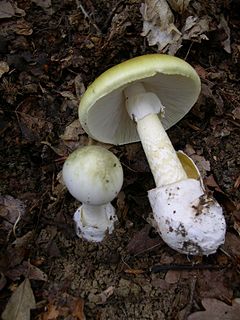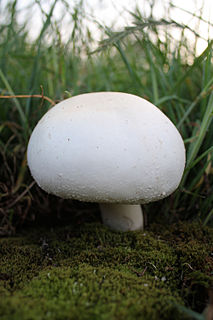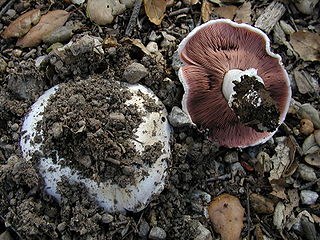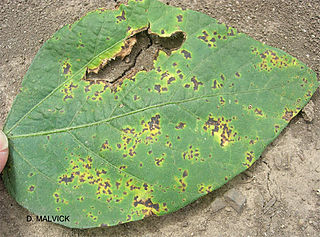
A mushroom or toadstool is the fleshy, spore-bearing fruiting body of a fungus, typically produced above ground, on soil, or on its food source.

Edible mushrooms are the fleshy and edible fruit bodies of several species of macrofungi. They can appear either below ground (hypogeous) or above ground (epigeous) where they may be picked by hand. Edibility may be defined by criteria that include absence of poisonous effects on humans and desirable taste and aroma.

Agaricus bisporus is an edible basidiomycete mushroom native to grasslands in Europe and North America. It has two color states while immature – white and brown – both of which have various names, with additional names for the mature state.

Pseudomonas is a genus of Gram-negative, Gammaproteobacteria, belonging to the family Pseudomonadaceae and containing 191 validly described species. The members of the genus demonstrate a great deal of metabolic diversity and consequently are able to colonize a wide range of niches. Their ease of culture in vitro and availability of an increasing number of Pseudomonas strain genome sequences has made the genus an excellent focus for scientific research; the best studied species include P. aeruginosa in its role as an opportunistic human pathogen, the plant pathogen P. syringae, the soil bacterium P. putida, and the plant growth-promoting P. fluorescens, P. lini, P. migulae and P. graminis

Mushroom poisoning refers to harmful effects from ingestion of toxic substances present in a mushroom. These symptoms can vary from slight gastrointestinal discomfort to death in about 10 days. The toxins present are secondary metabolites produced by the fungus. Mushroom poisoning is usually the result of ingestion of wild mushrooms after misidentification of a toxic mushroom as an edible species. The most common reason for this misidentification is close resemblance in terms of colour and general morphology of the toxic mushrooms species with edible species. To prevent mushroom poisoning, mushroom gatherers familiarize themselves with the mushrooms they intend to collect, as well as with any similar-looking toxic species. The safety of eating wild mushrooms may depend on methods of preparation for cooking.

Agaricus subrufescens is a species of mushroom, commonly known as almond mushroom, mushroom of the sun, God's mushroom, mushroom of life, royal sun agaricus, jisongrong, or himematsutake and by a number of other names. Agaricus subrufescens is edible, with a somewhat sweet taste and fragrance of almonds.

Agaricus arvensis, commonly known as the horse mushroom, is a mushroom of the genus Agaricus.
Pseudomonas agarici is a Gram-negative soil bacterium that causes drippy gill in mushrooms. It was first isolated in New Zealand. P. agarici could not be grouped based on 16S rRNA analysis, so it is designated incertae sedis in the genus Pseudomonas.

Pseudomonas cichorii is a Gram-negative soil bacterium that is pathogenic to plants. It has a wide host range, and can have an important economical impact on lettuce, celery and chrysanthemum crops. P. cichorii was first isolated on endives, from which it derives its name. It produces 6-aminopenicillanic acid. Based on 16S rRNA analysis, P. cichorii has been placed in the P. syringae group.
Pseudomonas tolaasii is a species of Gram-negative soil bacteria that is the causal agent of bacterial blotch on cultivated mushrooms. It is known to produce a toxin, called tolaasin, which is responsible for the brown blotches associated with the disease. It also demonstrates hemolytic activity, causing lysis of erythrocytes. Based on 16S rRNA analysis, P. tolaasii has been placed in the P. fluorescens group.
Pseudomonas viridiflava is a fluorescent, Gram-negative, soil bacterium that is pathogenic to plants. It was originally isolated from the dwarf or runner bean, in Switzerland. Based on 16S rRNA analysis, P. viridiflava has been placed in the P. syringae group. Following ribotypical analysis misidentified strains of Pseudomonas syringae pv. ribicola and Pseudomonas syringae pv. primulae were incorporated into this species. This pathogen causes bacterial blight of Kiwifruit.
Pseudomonas oryzihabitans, also known as Flavimonas oryzihabitans, is a nonfermenting yellow-pigmented, gram-negative, rod-shaped bacterium that can cause sepsis, peritonitis, endophthalmitis, and bacteremia. It is an opportunistic pathogen of humans and warm-blooded animals that is commonly found in several environmental sources, from soil to rice paddies. They can be distinguished from other nonfermenters by their negative oxidase reaction and aerobic character. This organism can infect individuals that have major illnesses, including those undergoing surgery or with catheters in their body. Based on the 16S RNA analysis, these bacteria have been placed in the Pseudomonas putida group.
Pseudomonas costantinii is a Gram-negative bacterium that causes brown blotch disease in cultivated mushrooms. It demonstrates hemolytic activity. The type strain is CFBP 5705.

Agaricus bitorquis is an edible white mushroom of the genus Agaricus, similar to the common button mushroom that is sold commercially. The name supersedes Agaricus rodmani. It is also commonly known as torq, the banded agaric, spring agaric, or pavement mushroom, as it has been recorded pushing up paving slabs.

Agaricus bernardii, commonly called the salt-loving mushroom, is an agaric fungus in the family Agaricaceae. A short, squat mushroom, the thick stem is usually less than the diameter of the cap, which ranges from 5–15 cm (2.0–5.9 in). Found in Asia, Europe, North America, New Zealand and at Snowy River Station Corringle Beach Australia it is a salt-tolerant species that grows in salt marshes, dunes, and coastal grassland. The fungus produces fruit bodies (mushrooms) with convex to flattened caps up to 15 cm (5.9 in) in diameter, atop thick stems up to 10 cm (3.9 in) long. The cap surface is whitish to buff, and can develop scales or warts in age. Gills are initially pink before turning brown when the spores mature. The flesh turns reddish when it is cut or bruised. The mushroom somewhat resembles Agaricus bitorquis but it differs from that species by the reddish-brown staining of cap and stem tissue, the nature of the ring on the stem, as well as its briny odor. An edible mushroom, it is stronger in flavor but similar to the store-bought button mushrooms, Agaricus bisporus.
Tolaasin, a toxic secretion by Pseudomonas tolaasii, is the cause of bacterial brown blotch disease of edible mushrooms. Tolaasin is a 1985 Da lipodepsipeptide non-host specific toxin. In addition to forming an amphipathic left handed alpha-helix in a hydrophobic environment, the toxin has been shown to form Zn2+-sensitive voltage-gated ion channels in planar lipid bilayers and to catalyze erythrocyte lysis by a colloid osmotic mechanism. At high concentrations, tolaasin acts as a detergent that is able to directly dissolve eukaryotic membranes.[1]

Agaritine (AGT) is an aromatic, antiviral, hydrazine-derivative mycotoxin and IARC Group 3 carcinogen that occurs in mushroom species of the genus Agaricus.

Bacterial Wilt of Carnations is a bacterial disease caused by the plant pathogen Paraburkholderia caryophylli. Previously, named Pseudomonas caryophilli, the pathogen is an aerobic gram negative bacteria known for only being capable of entering its host through wounds. Once inside the host, it colonizes the vascular system and roots causing symptoms such as, internal stem cracking, yellowing of the leaves, wilting, and the development of cankers. As a bacterial disease, Bacterial Wilt of Carnations can also be characterized by signs such as bacterial streaming, and bacterial ooze.
Verticillium dry bubble, recently named Lecanicillium fungicola, is a mycoparasite that attacks white button mushrooms, among other hosts, during its generative period. L. fungicola infects the casing layer on the cap structure of several edible mushrooms. This fungal pathogen does not typically infect wild mushrooms, but more commonly cultivated mushrooms are infected such as A. bisporus, which are typically grown in large quantities. Severity of disease depends on several factors, including timing of infection and environmental conditions. Dry bubble follows the typical verticillium life cycle, although insect vectors play a large role in the spread of this disease. Control for L. fungicola is limited, and strict measures must be taken to prevent the spread of infection. L. fungicola is a devastating pathogen in the mushroom industry and causes significant losses in the commercial production of its main host A. bisporus. Annual costs for mushroom growers are estimated at 2–4% of total revenue.

Bacterial blight of soybean is a widespread disease caused by Pseudomonas syringaepv. glycinea.












